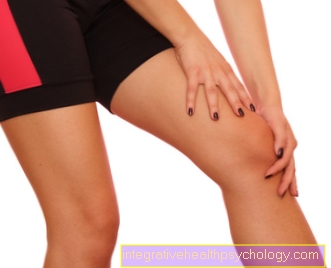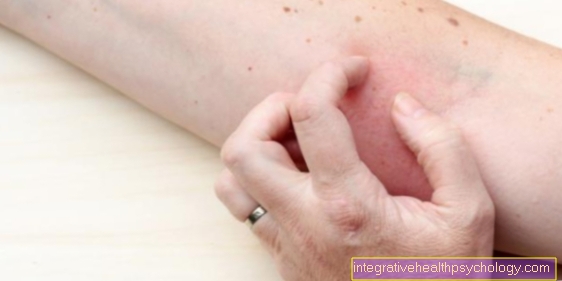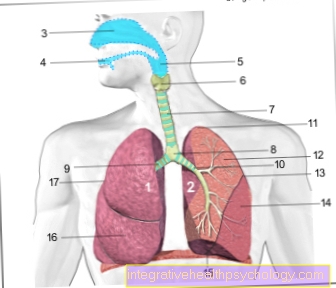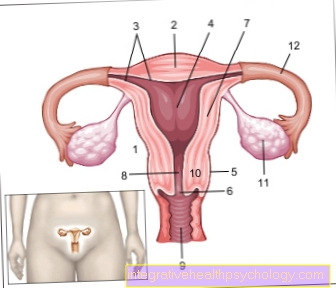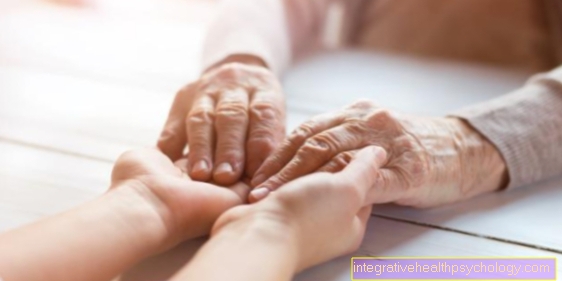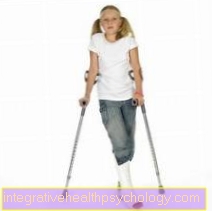Laser therapy
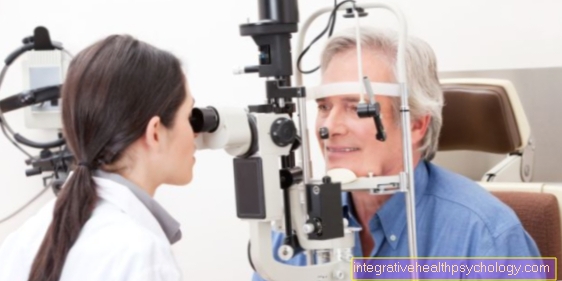
Definition - what is laser therapy?
Laser therapy describes a medical application in which bundled light beams in the form of a laser are shot at a lesion on the body. It is often used on eyes and skin, for example when removing moles or scars. There are different types of laser treatment, depending on the lesion and the goal of therapy. A distinction is made between laser ablation, coagulation, epilation and phototherapy. The laser kills cells and can be removed.
Indications
There are many uses for laser therapy. It is used particularly frequently in the field of cosmetics or dermatological therapy for skin diseases.
In the cosmetic field, it can help with the removal of scars or birthmarks, as well as with permanent hair removal. It can also be used to fight wrinkles or to remove enlarged veins (varicose veins).
Laser therapy is also often used for skin diseases such as acne, psoriasis, rosacea or nail fungus. It can also help in the treatment of malignant tumors.
acne
Acne is a disease of the sebum glands that occurs primarily on the face, chest, and back of adolescents. For the most part, it is a cosmetic problem, but in the case of massive infestation it can lead to severe restrictions on life and social isolation. The skin lesions can be treated with medication or laser therapy. The bundled rays of light kill bacteria in the sebum glands and prevent inflammation and spread. In addition, cells can be killed, so that the sebum glands shrink. Acne scars that have already formed can also be treated with a laser.
Here it goes to: Acne - This works best
arthrosis
Osteoarthritis is a degenerative disease in which long-term overuse and improper use leads to signs of wear and tear on the articular cartilage. It mainly occurs on the knee and hip in older people. The patients often complain of severe pain and restricted mobility. Surgical treatment is often the only therapy that can help. However, laser therapy can be an additional treatment measure, especially when treating pain. Especially with osteoarthritis of the small joints, for example on the fingers, a laser application can lead to a reduction in pain by activating pain-relieving processes in the body through the light rays.
Read more about the Osteoarthritis therapy
Nail fungus
The use of laser therapy for nail fungus is a rather newer method and in most cases we are not covered by health insurance. However, in the case of stubborn infestation and when medication no longer helps, it can alleviate the symptoms. The rays of light destroy the fungi in the nail and allow the nail to recover. There is also a laser-therapeutic destruction of the affected nail so that a new nail can grow back. As a rule, however, antifungal drugs (antimycotics) should also be taken.
Read here: This is how nail fungus is treated effectively
Inflammation
Laser therapy can activate pain-relieving and anti-inflammatory processes in the body when applied to the skin and joints. It can thus help treat inflammation. Especially with diseases that affect the musculoskeletal system, such as psoriasis, laser therapy can reduce pain and reduce inflammation. It also promotes wound healing. The light rays activate cells in the body that release substances for pain processing and anti-inflammatory processes.
Varicose veins
Varicose veins, medically called varices, are extensions of small, superficial veins. They arise because the venous valves no longer work and the blood cannot drain well. Often people are affected who have to stand for a long time. The result is greatly dilated veins on the skin, especially on the legs. There are different ways of treating varicose veins, laser therapy is one possibility. A laser is inserted into the vein and heat is generated using the light rays. This destroys the vein wall and closes the vein. This is used over a wide section of the vein so that the vein is completely closed after treatment.
More information here: Remove varicose veins
Spider veins
Similar to varices, spider veins are superficial, dilated veins. In contrast to varicose veins, however, this is a whole network of veins that often spread out on the legs to form net-like structures. They have no disease value, but are a cosmetic problem for most patients. To treat spider veins, the deeper vein from which the blood comes must be closed so that the spider veins no longer get blood. The laser therapy must therefore be applied to the deeper vein. In some cases, this is a problem as the laser cannot penetrate that deep. The decision must therefore be made individually.
Also read: Removing spider veins - this is the best treatment
Hair removal
A massive hair load or frequent shaving can be very annoying for some people. One method for long-term hair removal is laser therapy. Here, bundled light rays are directed onto the hair roots. The heat generated destroys the hair root, so that no more hair can grow at this point. Each hair must be treated individually. As a rule, several treatment appointments are necessary. However, the application depends on various factors, such as hair type, skin type and body region. The best results are achieved with dark hair.
You may also be interested in this article: Depilation - The different options
preparation
Before each treatment, the patient must be fully informed about the upcoming treatment by the attending physician. All possible risks must be explained and weighed up. The decision for laser therapy must be made individually for the patient, because it depends on the type of treatment and the patient himself. Usually it is an outpatient therapy, i.e. it is carried out in a practice or you can leave the hospital on the day of the operation. In most cases, blood tests are not necessary either.
procedure
The course of a laser treatment also depends on the underlying disease and the extent of the application. Laser therapy is usually carried out on an outpatient basis in a practice. In some cases, the treated area is first anesthetized locally with an analgesic, as the laser application can be very painful. In most cases, anesthesia is not necessary. Both the patient and the doctor must wear protective goggles, as the laser can damage the eyes. A special device is used to shoot the laser beam at the part of the body. Usually this is not a continuous beam, but a large number of beam shots. Usually several treatment appointments are necessary. After the treatment, the skin needs special care.
Risks
During laser therapy, heat is generated that can damage the skin. Incorrect use can cause burns or minor wounds that can become infected. In addition, scars, redness, blisters or edema can develop. A laser has negative effects on the eye in particular, which is why protective goggles must always be worn. It can also cause severe pain. It should be ensured that the treating doctor has already performed some laser therapies and has a qualified certificate.
Is that painful?
Applying a laser to the skin is often a painful treatment. However, it depends on the place of treatment. The application of the light rays leads to small stabbing pains, similar to a small electric shock. A single shot of the laser beam is not painful, but since a large number of laser shots are applied, this can cause pain over time. The obliteration of veins is also painful, which is why this is often done under local anesthesia.
Duration
The duration depends on the type of treatment and the underlying disease. The removal of individual birthmarks or scars usually takes a few minutes. If hair is to be removed from a larger area during the laser treatment, this can take a long time. Often, however, a single treatment is not enough and requires several sessions. The entire treatment can therefore take 3 to 6 months or more. With hair removal, for example, it can take several years. Initially, meetings are scheduled every 4 weeks, later every six months.
The duration of the treatment also includes the follow-up treatment. This is very important for a good outcome of the procedure. Going to the solarium or sunbathing for long periods of time should be avoided for up to six weeks after the therapy, as UV rays can damage the stressed skin. It is therefore advisable to have a laser treatment carried out in winter.
costs
The cost of treatment also depends on the type of treatment and the underlying disease. A laser therapy session for joint diseases costs between € 30 and € 100. For hair removal, a session costs € 500-700. The treatment is often offered as a private service and must be borne by the patient himself. However, depending on the illness, the costs can also be covered by the health insurance company. It is therefore advisable to contact the health insurance company beforehand.
Will the health insurance take care of that?
Whether the costs are covered by the health insurance company depends on the health insurance company and the illness. In most cases, the statutory health insurance does not cover the use of laser therapy. In some cases, however, a private health insurance company will cover them, depending on the tariff paid. You should therefore find out beforehand from your health insurance company that the costs will be covered. In the case of arthritic or chronic diseases in particular, the treatment is often paid for by the health insurance company.
What are the alternatives?
There are many alternative treatments in medicine depending on the disease. When treating varicose veins or spider veins, sclerotherapy or surgical treatment can be used. Moles can also be surgically removed. In the case of nail fungus, the use of antifungal agents should first be tried. In the case of osteoarthritis, laser therapy should only be an additional treatment, as the osteoarthritis can most likely be cured by surgery. Unfortunately, there are still few alternatives for long-term hair removal.


